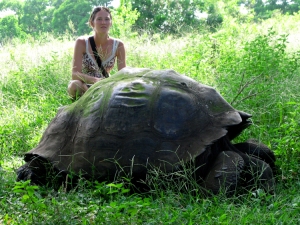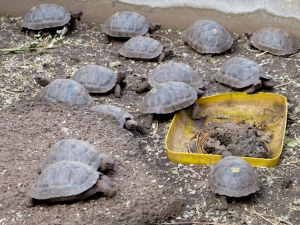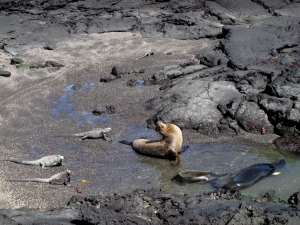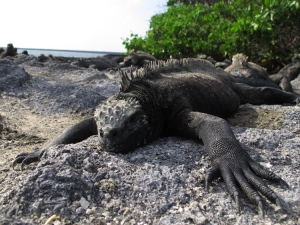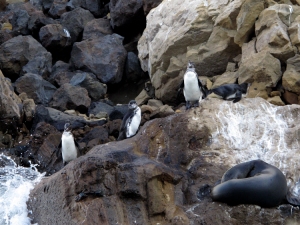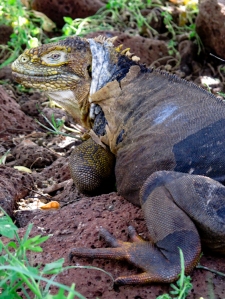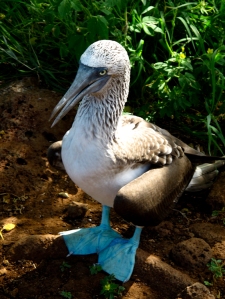What’s with these early mornings when you’re on vacation? We had a 6:30 breakfast this morning and then we were all shuttled to shore at Santa Cruz Island (population 20,000) via Zodiac. As I mentioned yesterday, we were reentering civilization today for a tour of the Charles Darwin Research station, which is home to the giant tortoise breeding program. Giant tortoises nearly became extinct due to over-harvesting for food by pirates and other mariners who visited the islands in the eighteen and nineteen hundreds. Now, though, thanks to the breeding program, their numbers have risen dramatically and scientists know much more about the reptiles than when they first began their program. For instance, each island has its own species of giant tortoise and those tortoises have adapted to the conditions on each specific island. The shape of their shell is an indicator of where they came from. You may have heard of Lonesome George, who is the last and only known living tortoise from Pinta Island. The researchers are trying to get him to mate with other females (from different islands), but it took him 12 years to finally befriend one of them (he’s somewhere between 90 and 120 years old), so progress is slow. Nobody knows exactly how old giant tortoises can live to be, but estimates exceed 200 years old! Here he is:
Our guide gave us a tour of the research station, starting with the baby tortoises in their nursery and moving on to the older ones who, for some reason or another, can’t be reintroduced into the wild. Some of them are GIGANTIC. Like over three or four hundred pounds. I couldn’t get over them and snapped photo after photo. They’re so slow and sedated, so it’s fascinating to watch them.
After the research station, C and I walked through the town Puerto Ayora, which is the largest town on the island. Both sides of the street are flanked with souvenir shops and cafes and typical tourist haunts. C and I picked up a fresh coconut each and slurped down the sweet water while wandering downtown. Everybody met at a restaurant called The Rock and there we boarded buses that would take us into the highlands. Our first stop was at El Trapiche where we learned how they processed sugar cane into just about everything. They press the cane into sugar cane juice, fermented it into strong (and barely consumable) alcohol, boiled it down into molasses, and evaporated it into sugar cubes. It was really interesting. We also saw how they processed coffee beans by smashing the pods, fanning away the husks, and roasting the beans over an open fire.
Once we had our fill of sugar can juice and coffee, we boarded the buses again and continued up the road to our next destination: lunch. The place we were eating at was tucked away on a dirt road without much of a sign directing you there. I’m not sure who eats there when we’re not in town, but it was beautiful. It kind of struck me as belonging in a rural setting somewhere in Tuscany. There was a pool and gardens, a volleyball net and several tiers of open-aired dining rooms. The food was ok, not great, but I’ve been spoiled on board anyways.
After lunch we got back on the buses and headed even further into the highlands. We were in search of giant tortoises in the wild. At our disembarkation spot, we divided up into smaller groups, each with a naturalist, and set out to see what we could find. We walked for about 2 hours and I think we came across 4 or 5 in total. All were massive and happily munching on green grass. I liked how our guide said that we should take tips from them if we want to live longer: eat vegetarian and exercise a lot. It doesn’t look like tortoises exercise much, but carrying that heavy shell around day and night is quite demanding, I’m sure.
After our walk, we returned to Puerto Ayora with the option of staying in town to do more shopping, or returning to the boat for a nap. C and I chose the boat (although we didn’t nap). I can’t believe tomorrow is our last full day in the Galapagos! It feels like it’s flown by, but we have seen some awesome stuff and been some incredible places. Hopefully tomorrow will bring more of the same!
Filed under: Ecuador, Lindblad Expeditions, Travel | Tagged: charles darwin research station, Ecuador, Galapagos Islands, giant tortoises, Lindblad Expeditions, lonesome george, puerto ayora, South America, sugar cane, Travel | Leave a comment »


